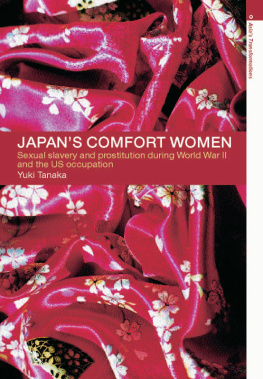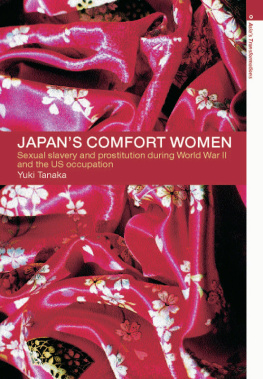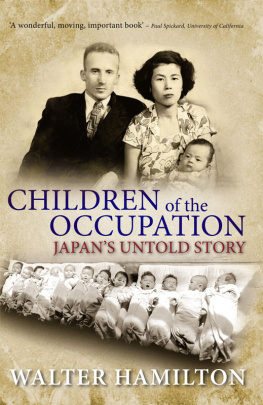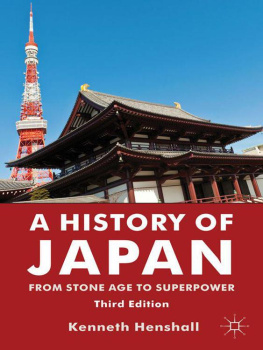The Allied Occupation
and
Japan's Economic Miracle

At the inauguration of the Science Council of Japan, 21 January 1949, Dr Harry C. Kelly, Acting Chief, Scientific & Technical Division, ESS, GHQ, SCAP, reads a congratulatory message to Japan's scientists. On the left, acting as interpreter as an ESS/ST staff member, is Masao Yoshida, son of the Prime Minister, Shigeru Yoshida.
The Allied Occupation
and
Japans Economic Miracle
Building the Foundations of Japanese Science
and Technology 1945-52
Bowen C. Dees
The Allied Occcupation
and Japans Economic Miracle
First published 1997 by
JAPAN LIBRARY
Published 2013 by Routledge 2 Park Square, Milton Park, Abingdon, Oxon OX14 4RN
711 Third Avenue, New York, NY 10017 USA
Routledge is an imprint of the Taylor & Francis Group, an informabusiness
1997 Bowen C. Dees
All rights reserved. No part of this publication may be reproduced, stored in a retrieval system, or transmitted in any form or by any means, without prior permission from the Publishers in writing, except for the use of short extracts in criticism.
British Library Cataloguing in Publication Data
A CIP catalogue entry for this book is
available from the British Library.
ISBN 978-1-315-07341-5 (eISBN)
Typeset in Stone 9 on 12pt by LaserScript Ltd., Mitcham Surrey
For Sarah
Contents
I owe a debt of gratitude to many people in connection with this work. Very special thanks are due Dr Samuel Coleman, who not only encouraged me to undertake the task of writing this book, but generously provided me a great deal of relevant information he had accumulated; he also gave me very useful advice on the first few chapters.
My colleague during Tokyo days, David Putnam, provided me a copy of the unpublished manuscript of the history of ESS/ST which he had prepared before the Occupation ended, and it has been very useful; quite a few of the materials made available by Dr Coleman had been given to him by David. The late Dr Paul Henshaw (also a Tokyo colleague) encouraged me to do this writing, and provided me with some interesting recollections.
Special thanks are due to John G. O'Brien, the son of Brigadier John O'Brien, who allowed me to use the five-volume set of his father's Journal for the years 1945-50. The contents of these notes by the man who headed the Scientific and Technical Division for all but a few months of its life provided many useful insights which helped enormously in rounding out the impersonal material available from the National Archives.
Three successive heads of the National Science Foundation's Tokyo office (Charles Wallace, Alexander DeAngelis and Larry Weber) were most helpful in a variety of ways; they and Masanobu Miyahara, a long-time adviser in that office, provided invaluable help - in acquiring and sending me material and in answering numerous questions.
Masao Yoshida, one of my most valued Japanese colleagues in ESS/ST, has also been very helpful. Other Japanese who have provided me with useful insights include two who were close to activities with which ESS/ST was involved - Dr Kiyoo Wadachi and Mr Kohei Suzue, Drs Kodi Husimi and Sogo Okamura (both of whom have held important positions in the Science Council of Japan) were generous with comments which helped me understand the Council's present status. I also owe thanks to Mr Yukihiro Hirano of the National Institute of Science and Technology Policy for providing me several helpful reports issued by that organization.
Six scholars on matters Japanese - Professors James Bartholomew, John Dower, Morris Low, Shigeru Nakayama, Richard Samuels and Michael Schaller - kindly read the manuscript as it was approaching completion and gave me useful comments. So did my friend Herbert Rhodes, who read the manuscript not as a specialist on Japan but as an interested reader. Joanne Kauffman, co-author of Science Knows No National Borders, provided me some useful material. Harry Kelly's son, Dr Henry Kelly, allowed me access to his father's papers at North Carolina State University, and relevant items from these holdings were made available to me by Mr Maurice Toler, University Archivist at NCSU.
Many others have helped in various ways, and I would like to thank all those who provided materials, suggestions and encouragement as this book took shape, including especially my former Tokyo colleagues Dr Donald J. Pletsch and William Kight.
Without the encouragement, assistance (and tolerance) of my wife Sarah, this book would never have been written. For years she urged me to make a record of the work of the Scientific and Technical Division, and her patience as the research and writing were being done and her many helpful editorial suggestions were of the utmost importance. I also owe gratitude to our daughter, Sarah Edna Marble, who provided a substantial amount of editorial assistance.
BOWEN DEES
Tucson, Arizona
February 1997
An American who had served in General MacArthur's Headquarters during the Occupation of Japan returned to Tokyo for the first time after a lapse of more than forty years. His first taxi ride took him past the Dai Ichi Building. He said to his young English-speaking driver, 'That is the building where General MacArthur had his office.' The startling response was 'Who was General MacArthur?' 'Why, he was the Supreme Commander for the Allied Powers during the Occupation.' 'What Occupation?' asked the taxi driver, obviously truly puzzled.
Some five decades after the August 1945 Japanese surrender, the number of Japanese who were adults during the Occupation years has become a small fraction of the population. Most young people (whether in Japan or elsewhere) would consider the 1945-52 period as long ago - and the schools in Japan play down the role of the Japanese military before and during World War II - and they deal very little with the role played by the Allied Occupation during the nearly seven years following Japan's defeat and surrender.
Numerous books have been written dealing with the factors that made it possible for Japan, a relatively small country, poor in natural resources, to become an economic superpower. Some writers have dealt specifically with ways in which the Allied Occupation helped to 'jump start' Japan on its way to becoming the enormous industrial power it is today. Few of the books in this substantial body of literature give more than passing mention to science or engineering.
This book puts on record the work done in Japan during the Allied Occupation by a small group of scientists and engineers from the United States and Australia; I was one of those involved during most of the Occupation period. We were mainly concerned with helping the Japanese get back on their feet scientifically and back into the mainstream of world scientific and technological activity after nearly a decade during which they were almost totally cut off from the world scientific community.
Our unit was the Scientific and Technical Division of the Economic and Scientific Section of the General Headquarters of the Supreme Commander for the Allied Powers - shortened to ESS/ ST GHQ SCAP (or, in this account, ESS/ST). Most of us were relatively young - and, of necessity, brash.











